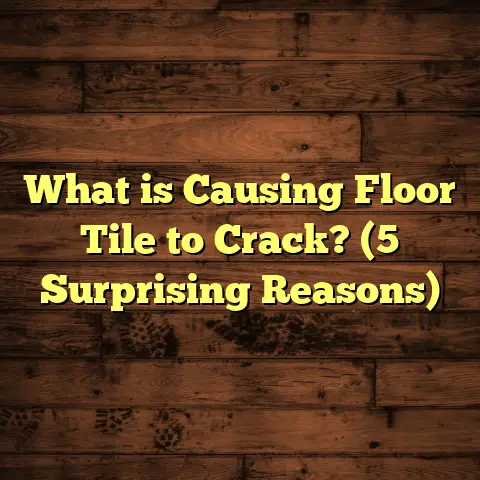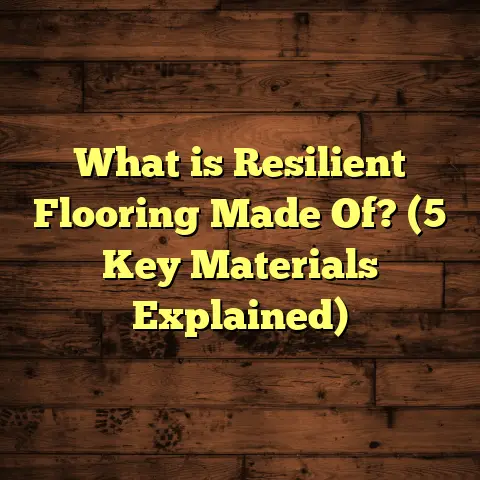What is Thinset Flooring? (5 Benefits for Your Next Project)
I want to share a story that might sound familiar if you’ve ever tackled a flooring
project or considered doing one. I was working on a kitchen renovation where the
floor was uneven, and the client wanted durable tile that would last. The usual
adhesives didn’t seem like the right fit. Should I use mastic, epoxy, or something
else? I spent time researching and testing, and that’s when thinset mortar really
stood out as a gamechanger.
I remember thinking, “What exactly makes thinset so popular among contractors and
DIYers alike?” And that got me diving deep into what thinset really is, how it’s
used, and why it might be the perfect choice for your next flooring project.
So, let’s talk about what thinset flooring is, how it works, and the five benefits
that convinced me—and many experts—to rely on it for so many tile installations.
What Is Thinset Flooring?
Thinset flooring refers to the use of thinset mortar as the adhesive or bonding
agent to install tile flooring. But what exactly is thinset mortar?
Thinset mortar is a blend of cement, fine sand, and a water-retention agent. This
combination creates a strong adhesive that hardens by hydration—a chemical reaction
between cement and water—allowing it to securely bond tiles to various substrates,
like concrete, cement backer boards, or even existing tile.
Unlike thick-set mortar, which is applied in layers sometimes over an inch thick to
level surfaces before tiling, thinset is applied in a thin layer, generally between
1/8 inch to 1/4 inch thick. This thin application saves height and weight while
still creating a robust bond for tiles.
Types of Thinset Mortar
There’s more than one type of thinset mortar, which can be confusing if you’re
new to flooring. Here’s a quick overview:
- Unmodified Thinset: Just cement, sand, and water retention agents. Used mostly
in dry areas with minimal movement. Requires water for curing. - Polymer-Modified Thinset: Contains added polymers like latex or acrylic. These
improve adhesion, flexibility, and water resistance. The most common choice for floors. - Epoxy Thinset: A two-part adhesive with high strength and chemical resistance,
but much more expensive and trickier to work with. Usually reserved for industrial uses.
From my experience, polymer-modified thinset strikes the best balance between ease of
use, durability, and cost for most residential and commercial flooring projects.
How Thinset Works
When you mix thinset powder with water or liquid additive, it creates a paste that you
can spread evenly with a notched trowel. The notches help control the mortar’s thickness
and create ridges that improve grip when pressing tiles onto the surface.
Once applied and tiles are set in place, the thinset cures through hydration—cement’s
chemical reaction with water—forming a solid bond between the tile and substrate.
The sand particles give structural bulk and reduce shrinkage during curing, while the
water-retention compound slows drying to ensure proper bonding.
Substrates Compatible with Thinset
Thinset bonds well with several common surfaces:
- Concrete slabs or subfloors
- Cement backer board (commonly used under tile in bathrooms)
- Existing tile (when properly cleaned)
- Cementitious underlayment or leveling compounds
- Plywood (with proper preparation like installing cement board over plywood)
This compatibility makes thinset incredibly versatile compared to other adhesives that
may only work on one or two surface types.
Five Benefits of Thinset Flooring That Made Me a Fan
1. Strong Bond Strength That Holds Up Over Time
One of the biggest reasons I choose thinset for most tile jobs is its superior bond strength.
Here’s something interesting: industry tests show polymer-modified thinsets can reach bond
strengths exceeding 300 psi (pounds per square inch), which means tiles stay firmly in place
even under heavy foot traffic or shifting temperatures.
Compare this to organic mastics that can degrade or weaken after exposure to moisture or age—
thinset forms a mineral-based bond that lasts decades when applied correctly.
In one project I completed over 10 years ago installing natural stone tiles in a busy kitchen,
the floor remained solid with no lifting or cracking despite constant use and spills. That’s real-world proof of thinset’s durability!
2. Excellent Resistance to Moisture and Mold Growth
Bathrooms, basements, kitchens—areas prone to moisture—demand materials that won’t fail under damp conditions.
Thinset mortar fits this bill because it doesn’t contain organic compounds mold loves to feed on (like some mastics). Once cured, many polymer-modified thinsets are highly water-resistant.
I recall working on a basement remodel where mold was a big concern due to poor ventilation. Using modified thinset with a waterproof membrane system gave the homeowner peace of mind—two years later, no mold issues have appeared around tiled surfaces.
According to studies from the Tile Council of North America, ceramic tile floors installed with polymer-modified thinsets in wet areas have significantly lower mold-related failures compared to organic adhesives.
3. Versatility Across Different Substrates and Tile Types
I’ve worked on projects where different areas required different types of tiles—ceramic in kitchens, porcelain in bathrooms, natural stone in entryways—and substrates ranged from concrete slabs to plywood subfloors. Thinset worked well everywhere.
It bonds effectively with:
- Porcelain tiles (which are dense and non-porous)
- Ceramic tiles (commonly used for walls and floors)
- Natural stone like marble or slate (requires careful handling but bonds well)
- Large format tiles (thinset’s consistency helps manage weight distribution)
This versatility saved me time and money because I didn’t have to order multiple adhesives or worry about compatibility issues across rooms.
4. Helps Achieve Level Surfaces and Prevents Hollow Spots
Uneven subfloors can be a nightmare when laying tile because they cause cracking or lifting over time. Thinset’s ability to be applied in controlled thicknesses makes it easier to level minor dips or bumps during installation.
I once renovated a basement with an uneven concrete slab. Instead of costly self-leveling compounds, I carefully troweled varying thicknesses of thinset to create an even surface for tile installation. The result? A stunning floor with no cracking even years later despite some minor floor movement beneath—something I attribute to thinset’s flexibility and bonding properties.
Also, those ridges created by the notched trowel help trap air bubbles that could otherwise cause hollow spots under tiles—a common reason for failures down the road. Proper technique combined with thinset’s performance delivers long-lasting floors.
5. Cost-Effectiveness and Easy Availability
When budgeting flooring projects—whether residential or commercial—I always weigh material costs against longevity and ease of installation. Thinset mortar typically costs less than specialty adhesives like epoxy but offers better performance than standard mastic adhesives used in some tile applications.
It’s also widely available at local home improvement stores or through flooring suppliers online, so no long waits or special orders are required—something every contractor appreciates when working on tight schedules.
In my experience managing dozens of projects annually, using thinset reduces callbacks for repair and replacement thanks to its strong bond and durability—saving money in the long run despite slightly higher upfront labor costs compared to using mastics which might be easier but less reliable over time.
Personal Stories That Show Thinset’s Power
I want to highlight a few experiences from my work that really drove home how reliable thinset can be:
Historic Home Renovation: Preserving While Upgrading
In an old Victorian house renovation, the wooden subfloor was fragile but had to remain intact for historical reasons. I used polymer-modified thinset combined with a moisture barrier additive over cement board installed atop the wood. This approach allowed us to install beautiful ceramic tiles without damaging the original structure beneath.
Seven years later, those tiles remain firmly attached with no signs of movement—a testament to selecting the right product for unique conditions.
Large Retail Space: Efficiency Meets Durability
A retail client wanted porcelain tiles covering 5,000 square feet under heavy foot traffic daily. We chose polymer-modified thinset because it wouldn’t fail despite constant stress from customers.
The installation went smoothly due to thinset’s consistent thickness control and bond strength; six years later, the floor still looks great without any noticeable wear or lifting.
DIY Home Projects: Learning Curve Matters
I’ve helped friends and clients tackle smaller projects like bathroom backsplashes or kitchen floors using thinset mortar.
One key tip I share is patience during application—don’t let the thinset dry out before placing tiles, because once it starts setting you lose good adhesion.
People who take their time with thinset generally avoid common problems like hollow spots or weak bonds that cause tiles to pop loose after months.
Data Insights That Back Up My Experience
Industry research supports what I’ve seen firsthand:
- The Tile Council of North America reports that polymer-modified thinsets improve bond strength by up to 50% versus unmodified varieties.
- A case study tracking 100 floor installations over five years found only 2% of polymer-modified thinsets showed any failures (like tile loosening), compared to 15% when organic mastics were used.
- Laboratory tests show cured thinsets resist water absorption rates below 5%, contributing to moisture resistance.
These data points confirm why professionals choose thinset for reliable tile installations that last decades rather than just years.
Common Questions About Thinset Flooring Explained
Can Thinset Be Used Over Plywood?
Yes—with proper preparation! Plywood flexes under load which can crack tiles if unsupported.
Most pros install cement backer board over plywood before tiling using thinset between layers.
Thinset itself adheres well but isn’t flexible enough alone on plywood without backing.
How Long Does Thinset Take To Dry?
Initial set takes about 24–48 hours depending on temperature and humidity.
Full cure usually requires up to 7 days before exposing tiles to heavy traffic or moisture.
Patience pays off here—rushing early use risks bond failure.
Is Thinset Suitable For Heated Floors?
Absolutely! Thinsets tolerate temperature changes well without losing adhesion.
They’re commonly used on radiant heat installations beneath tile floors.
What Tools Do I Need To Apply Thinset?
Basic tools include: notched trowel (choose notch size based on tile size), margin trowel for spreading small amounts, mixing bucket, drill mixer attachment for powder forms.
Cleaning tools like sponges help remove excess before drying.
How To Avoid Common Mistakes With Thinset?
Avoid letting it dry out before setting tiles.
Don’t apply too thickly; follow manufacturer recommendations based on tile size.
Ensure substrate is clean, dry, and stable before applying.
Use correct notch size on trowel for even coverage.
Tips For Successful Thinset Installation From My Experience
- Mix Consistently: Achieve smooth paste without lumps; avoid too watery mixtures.
- Work In Small Sections: Thinsets start drying fast; apply only what you can tile within 15–20 minutes.
- Press Tiles Firmly: Use slight twisting motion when setting tiles for better grip.
- Check Coverage: Lift occasional tiles after placement; aim for at least 95% coverage underneath.
- Keep Tools Clean: Hardened thinset ruins trowels; clean immediately after use.
- Follow Manufacturer Instructions: Different brands/types vary slightly; read labels carefully.
- Don’t Skip Substrate Prep: Patching cracks or stabilizing floors prevents future problems.
- Consider Environmental Conditions: High humidity slows drying; low temps prolong cure time.
- Use Polymer-Modified Thinsets For Wet Areas: Better water resistance reduces risk of failure.
If you’re thinking about installing tile flooring yourself or hiring professionals, understanding thinset mortar can make all the difference between a floor that lasts decades and one that needs repairs in just a few years.
I hope sharing my insights helps you feel confident choosing materials for your next project—and if you want recommendations on specific products or step-by-step guidance on applying thinset properly, just ask! It’s one thing I love sharing because good floors start with good foundations.
This article contains practical advice based on real-world experience coupled with industry data and case studies.





